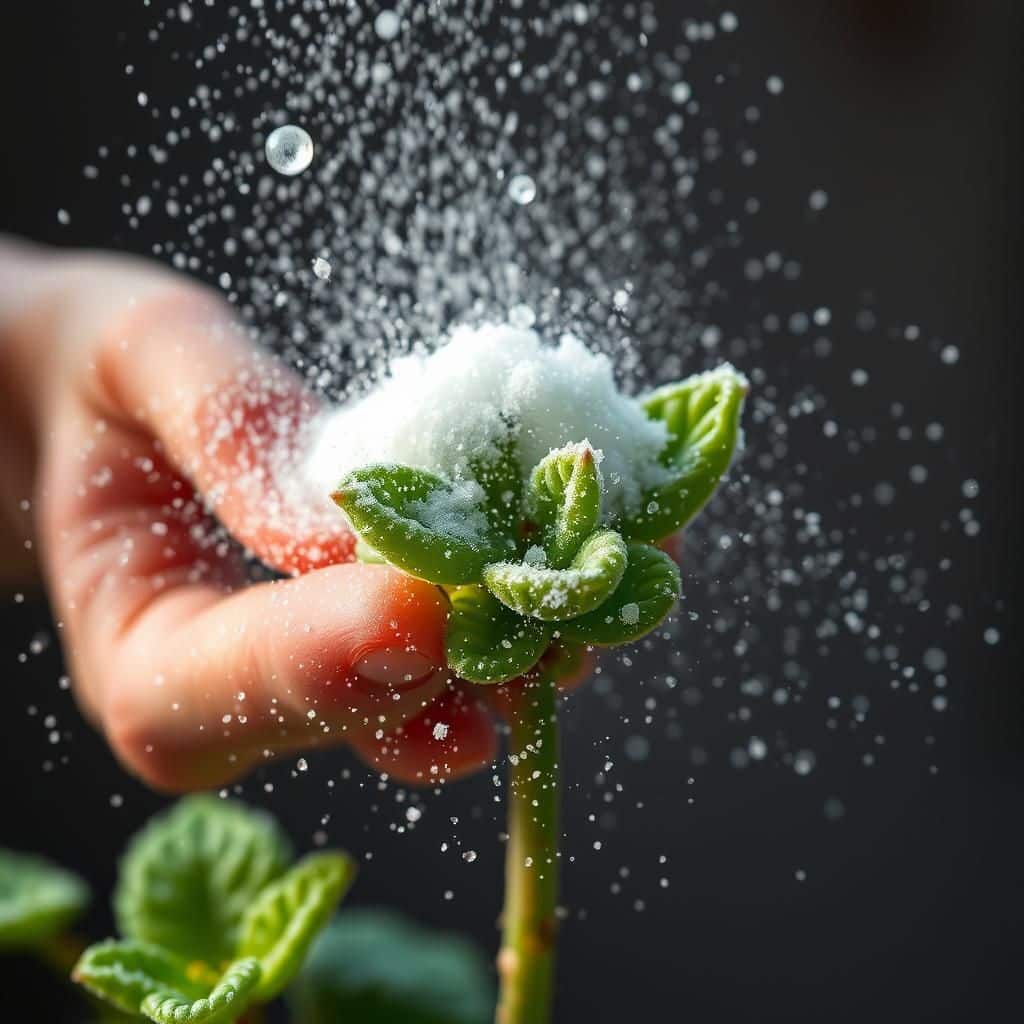What Happens When You Sprinkle Baking Soda on Your Plants? Discover the Surprising Benefits and Effects!

Baking soda, a common household ingredient, has gained attention for its potential benefits in gardening. When sprinkled on plants, it may offer surprising effects that go beyond mere baking applications. This seemingly simple compound can influence plant health, growth, and even pest management. gardeners have begun to explore its role as a natural remedy to boost plant vitality and protect against various ailments. In this article, we will delve into the science behind baking soda's effects on plants, highlighting its various benefits, potential applications, and the best practices for incorporating it into your gardening routine.
Effects of Sprinkling Baking Soda on Your Plants
Sprinkling baking soda on your plants can lead to a variety of effects that can be both beneficial and detrimental. The primary component of baking soda is sodium bicarbonate, which can help regulate soil pH when applied in moderation. This adjustment can promote healthier plant growth by making certain nutrients more accessible to the plants. However, excessive use might lead to sodium buildup in the soil, which could hinder the plant’s ability to absorb water and nutrients. Additionally, baking soda can act as a mild fungicide, helping to prevent certain fungal diseases, but its effectiveness may vary depending on the type of plants and the fungal issues present.
How Baking Soda Affects Soil pH
When baking soda is applied to the soil, it can increase the alkalinity of the soil, effectively raising the pH level. Many plants prefer a slightly acidic to neutral pH, so introducing too much baking soda can create an unfavorable environment for them. However, in certain cases, especially in soils that are overly acidic, baking soda can help balance the pH levels, making it easier for plants to absorb essential nutrients like nitrogen, phosphorus, and potassium.
The Role of Sodium in Plant Health
Sodium, while essential in small quantities, can be harmful to plants in higher concentrations. When baking soda is sprinkled on plants, sodium ions can accumulate in the soil, potentially leading to salt stress. This condition can interfere with a plant's ability to take up water, leading to dehydration and nutrient deficiency, especially in sensitive plants. It's crucial to monitor the quantity used and to consider the plant species being treated.
Using Baking Soda as a Fungicide
Baking soda has been recognized for its protective properties against various fungal infections that can affect plants. When mixed with water and sprayed onto foliage, its antifungal properties can help combat issues like powdery mildew and black spot. This natural remedy can be an alternative to chemical fungicides, although its effectiveness may not be as potent, and it works best when used preventively rather than as a cure for established infections.
Frequency and Amount of Application
To safely use baking soda on plants, moderation is key. Experts recommend mixing about 1 teaspoon of baking soda in 1 quart of water for a spray solution. Over-application can lead to sodium build-up, causing more harm than good. It is best to apply this solution once every few weeks, closely monitoring plant health and adjusting based on individual species needs and conditions.
Alternatives to Baking Soda
While baking soda can be helpful, there are alternative methods for managing soil pH and plant health. Lime can be used to raise soil pH, while sulfur can help to lower it. There are also commercial products designed to condition the soil and promote optimal nutrient levels without the risks associated with baking soda. Exploring these alternatives can often yield more consistent results for plant care.
| Aspect | Effect of Baking Soda |
|---|---|
| pH alteration | Can raise soil pH, potentially improving nutrient availability |
| Sodium impact | Can lead to salt stress if overused |
| Fungicide properties | May help prevent fungal diseases |
| Application frequency | Should be limited to avoid sodium accumulation |
| Alternatives | Lime and sulfur can be used instead |
Is it safe to sprinkle baking soda on plants?
:strip_icc()/Adding-Baking-Soda-to-Plants-in-Garden-1419286443-716191087dea4050a691a55157a69e2b.jpg)

Sprinkling baking soda on plants can serve various purposes, but it’s essential to understand its safety and potential effects on your plants. Baking soda, or sodium bicarbonate, has been known to have some benefits in gardening, however, it should be used with caution.
Potential Benefits of Baking Soda for Plants
Using baking soda can offer several advantages for plant health:
- Fungicide Properties: Baking soda can help combat certain types of fungal infections, such as powdery mildew.
- pH Level Adjustment: It can assist in changing the soil pH, making it slightly more alkaline, which might benefit certain plants.
- Pest Deterrent: Some gardeners report success using baking soda to deter pests like aphids and mites.
Safety Considerations When Using Baking Soda
While baking soda can be beneficial, there are important safety considerations:
- Concentration: Using too much baking soda can lead to high sodium levels in the soil, which can harm plants.
- Plant Sensitivity: Some plants may be more sensitive to the application, leading to leaf burn or other damage.
- Watering: Baking soda should ideally be mixed with water before application to mitigate potential negative effects.
How to Properly Apply Baking Soda to Plants
Proper application is crucial to avoid damaging plants:
- Dilution: Mix about 1 tablespoon of baking soda in a gallon of water.
- Spray Application: Use a spray bottle to lightly coat the leaves and soil, spreading it evenly for effective coverage.
- Frequency: Limit application to once every few weeks to prevent buildup in the soil.
Plants That Respond Well to Baking Soda
Certain plants seem to thrive with the application of baking soda:
- Tomatoes: They may benefit from baking soda for controlling fungal diseases.
- Cucumbers: Known to be susceptible to powdery mildew, baking soda can help.
- Peppers: Peppers may show improvements in disease resistance when treated with baking soda.
Alternatives to Baking Soda in Gardening
There are other organic options worth considering:
- Cornstarch: Acts as a thickening agent against pests.
- Neem Oil: A potent natural pesticide that targets a wide range of pests and diseases.
- Vinegar: Though more acidic, it can help with fungus when used strategically within the right concentrations.
What bugs are killed by baking soda?

Baking soda, also known as sodium bicarbonate, is recognized for its various household uses, including pest control. It can be an effective method for killing certain types of bugs due to its properties that disrupt their bodily functions. Here are some of the main insects that baking soda can help eliminate:
See also:
When mixed with sugar, baking soda becomes an attractive bait for certain insects. Upon ingestion, it reacts with the acid in their stomachs, producing carbon dioxide gas, which can be lethal.
1. Cockroaches
Baking soda is particularly effective against cockroaches. These pests can be quite resilient, but the combination of baking soda and sugar can lead to their demise.
- Baking soda is mixed with sugar to attract cockroaches.
- When consumed, the baking soda reacts in their digestive system.
- This reaction produces gas that leads to the cockroach's death.
2. Ants
Ants are attracted to sweet substances, making the baking soda and sugar mix an effective bait.
- Ants carry the mixture back to their colony.
- Other ants consume the bait, leading to widespread poisoning.
- The baking soda disrupts their digestive processes, ultimately killing them.
3. Bed Bugs
While not as effective as some commercial products, baking soda can have a negative effect on bed bugs by dehydrating them.
- Baking soda is sprinkled in areas where bed bugs hide.
- It gets into their exoskeletons and absorbs moisture.
- Over time, this dehydration can lead to their death.
4. Fleas
Baking soda can also help control a flea infestation in your home, particularly when combined with other methods.
- Sprinkling it on carpets and rugs can help dehydrate the fleas.
- As the fleas come into contact with the baking soda, it can disrupt their life cycle.
- A thorough vacuuming afterwards helps in removing dead fleas and eggs.
5. Silverfish
Silverfish are another pest that can be affected by baking soda treatments.
- When baking soda is sprinkled in areas where silverfish are active, it can lead to dehydration.
- Silverfish ingesting baking soda can disrupt their digestive system.
- Once again, the moisture-absorbing properties play a crucial role in their elimination.
Questions from Our Readers
What benefits does baking soda provide to plants?
Baking soda can be beneficial for plants primarily due to its pH-altering properties. When applied to the soil, it can help to neutralize acidity, promoting healthier growth for plants that prefer alkaline conditions. Additionally, baking soda can deter some pests and fungal infections, making it a useful natural remedy in gardening.
Can baking soda damage my plants if used excessively?
Yes, using baking soda in excessive amounts can potentially harm your plants. High concentrations may lead to salt buildup in the soil, affecting water absorption and potentially leading to plant stress or even death. It is important to use baking soda in moderation to avoid negative effects on plant health.
See also:
How do I properly apply baking soda to my plants?
To properly apply baking soda, you can mix about 1 tablespoon of baking soda with a gallon of water and spray it onto the leaves of your plants or apply it to the soil. This solution can help manage fungal diseases or improve soil quality without causing harm when used as part of a balanced regimen.
Is baking soda safe for all types of plants?
While baking soda is generally safe for many types of plants, it may not be suitable for those that prefer acidic soil conditions, such as azaleas or blueberries. Always consider your specific plant types and conduct a small test before applying it widely to ensure it won't negatively impact your garden ecosystem.

If you want to read more articles like What Happens When You Sprinkle Baking Soda on Your Plants? Discover the Surprising Benefits and Effects!, we recommend you check out our Plants category.
Leave a Reply
Related Articles